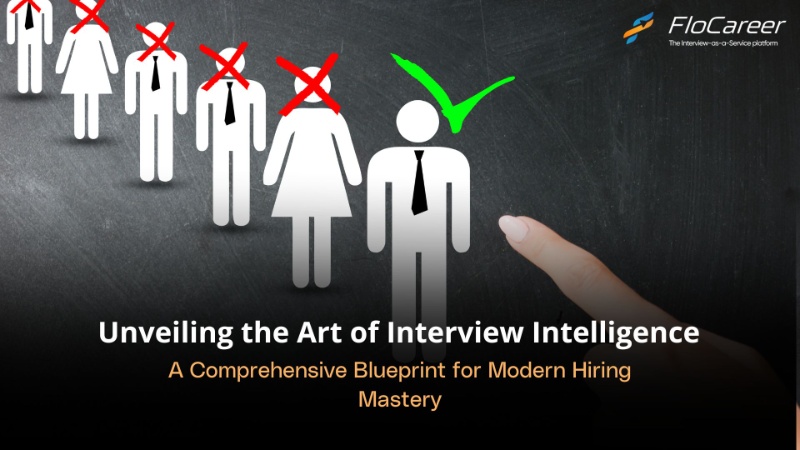Unveiling the Art of Interview Intelligence: A Comprehensive Blueprint for Modern Hiring Mastery
Mastering the art of interview intelligence has become a linchpin for organizations striving to make not just hiring decisions but strategic and informed choices that shape the very fabric of their teams. This blog serves as an in-depth exploration, unveiling the intricacies of interview intelligence—from its conceptualization to effective implementation—and dissecting each vital component that propels it into the realm of a transformative force in contemporary hiring practices.

What is Interview Intelligence?
Interview intelligence transcends the conventional boundaries of interview skills; it's a strategic approach, a mindset that permeates every aspect of the hiring process. More than just asking questions, it involves meticulous preparation, understanding corporate culture, and fostering a dynamic, insightful conversation between the interviewer and the candidate. It's a symphony where every note contributes to a meaningful exchange, transforming the interview from a transactional engagement to an impactful interaction that aligns organizational goals with individual aspirations.
How to Implement Interview Intelligence
1. Structured Interview Planning
Before the Interview:
Develop a comprehensive set of standardized questions meticulously aligned with the competencies crucial for the position. While many Applicant Tracking Systems (ATS) offer limited functionality in this aspect, tools like FloCareer’s interview planning tool provide a more extensive and coordinated approach, ensuring a thoughtful evaluation for each candidate.
Better Preparation for the Interview:
Arm interviewers with a comprehensive dossier, including the interview structure, candidate profiles, and a copy of the feedback form. FloCareer’s interview-assistant app takes this a step further, offering a centralized hub with intelligent suggestions for a seamlessly organized interview experience.
During the Interview:
Live Guidance and Feedback:
Provide interviewers with a structured flow for the perfect interview. Live guidance, if feasible, coupled with tools fostering structured and consistent conversations, ensures a dynamic and engaging interview. FloCareer’s interview assistant app goes beyond, providing relevant nudges to keep the interviewer on course and avoid potential pitfalls, such as illegal questions.
Ferocious Note-Taking:
Encourage interviewers to take objective and usable notes during the interview. Automated note-taking tools alleviate the burden of meticulous documentation, allowing interviewers to focus on actively listening to candidates, ensuring a positive experience.
After the Interview:
Better, Faster Feedback:
Facilitate detailed feedback from interviewers, providing instant access to crucial moments. Interview recordings serve as a valuable resource for instant contextual feedback suggestions. This asynchronous review of conversations expedites the decision-making process.
Collaborative and Data-Driven Decisions:
Leverage interview data for asynchronous collaboration and informed decision-making. Scrutinize skill ratings of past hires, evaluate diversity metrics, highlight significant candidate responses, and track interviewer trends such as question difficulty and skill coverage. These insights empower organizations to make well-informed and strategic hiring decisions.
2. Interview Recording and Analysis
Interview recording and analysis serve as the lighthouse guiding organizations through the continuous improvement of their hiring outcomes. Leveraging audio or video interview recording software captures interviews in their entirety. Periodic reviews of these recordings empower HR personnel and hiring managers to identify strengths and weaknesses in the interview process, ensuring an iterative approach to enhancement.
Implementing Interview Recording and Analysis:
Utilizing technology such as audio or video interview recording software becomes paramount for organizations seeking to embrace interview intelligence fully. The recording process not only captures the verbal exchange between the interviewer and the candidate but also unveils subtle nuances such as body language and tone—a holistic approach to evaluating the overall interaction.
The subsequent analysis of these recordings becomes a treasure trove of insights. By revisiting the interviews, organizations can identify patterns, strengths, and areas for improvement in their interviewing processes. It acts as a reflective tool for interviewers to enhance their skills, ensuring a continual evolution towards excellence.
3. Continuous Interviewer Training
Continuous training is the lifeblood that ensures interviewers are well-equipped with the latest techniques and skills. Regular training sessions covering diverse topics, including the development of structured interview plans, bias mitigation, and effective questioning techniques, are indispensable.
Crafting a Robust Continuous Interviewer Training Program:
Creating a continuous interviewer training program involves a strategic blend of theoretical knowledge and practical application. The program should encompass various dimensions, ensuring that interviewers are not only well-versed in the theoretical aspects of structured interviews but also adept at applying this knowledge during actual interactions.
Theoretical Framework:
Structured Interview Plans: Comprehensive training on developing structured interview plans, emphasizing the identification of key competencies for each position.
Bias Mitigation Techniques: Understanding and addressing unconscious biases that may influence the interview process.
Effective Questioning Strategies: Training on crafting questions that align with competencies and elicit valuable insights from candidates.
Practical Application:
Simulated Interviews: Providing opportunities for interviewers to conduct simulated interviews, applying the theoretical knowledge gained.
Feedback Sessions: Constructive feedback sessions post-simulated interviews, fostering a culture of continuous improvement.
Technology Integration:
Utilizing Interview-Assistant Tools: Integrating interview-assistant tools into the training process, allowing interviewers to become familiar with technological aids that enhance the interview experience.
Continuous training doesn't end with the initial onboarding but should be an ongoing process. Regular refresher sessions, updated training modules, and feedback loops contribute to the evolution of interviewers, ensuring they stay abreast of industry trends and continually refine their skills.
4. Data-Backed Hiring Decisions
Data-backed hiring decisions harness the power of analytics to inform and elevate the hiring process. The analysis of data, including employee performance, turnover rates, and engagement metrics, unveils the characteristics and competencies of successful employees.
Implementing Data-Backed Hiring Decisions:
Performance Metrics:
Employee Performance Reviews: Regular performance reviews serve as a foundational source of data. Identifying high-performing employees and analyzing the attributes contributing to their success forms the basis for informed hiring decisions.
Objective Measures: Incorporating objective measures such as sales targets, customer satisfaction ratings, or project milestones to quantify employee performance.
Employee Turnover Analysis:
Identifying Patterns: Analyzing turnover rates to identify patterns—whether certain roles have higher turnover or if there are commonalities in the reasons for employee exits.
Addressing Root Causes: Utilizing turnover data to address underlying issues contributing to employee attrition, ensuring a proactive approach to talent retention.
Diversity and Inclusion Metrics:
Evaluating Diversity Metrics: Scrutinizing diversity metrics to ensure a fair and inclusive hiring process. Assessing the representation of different demographics in the workforce becomes a crucial component of data-backed decisions.
Post-Hiring Outcome Analysis:
Monitoring Employee Engagement: Continuous monitoring of employee engagement post-hiring to gauge the impact of hiring decisions on organizational culture.
Adjusting Strategies: Adapting hiring strategies based on post-hiring outcomes, ensuring a dynamic and responsive approach to talent acquisition.
In conclusion, interview intelligence isn't just a tool; it's a mindset that organizations can embrace to make precise, informed hiring decisions and minimize turnover rates. By weaving the elements of structured interview planning, technology for recording and analysis, continuous interviewer training, and data-backed decision-making into the fabric of their hiring processes, organizations can transform their approach to talent acquisition.
Interview intelligence becomes the cornerstone, the guiding light that propels organizations towards not just selecting top talent but cultivating a workforce that aligns seamlessly with their vision and goals. Embrace interview intelligence, not just as a strategy, but as a dynamic journey that elevates your hiring practices to new heights of insight and mastery. The deliberate integration of these components ensures that interview intelligence isn't just a concept but a living, evolving force that continually refines and optimizes the hiring process. As organizations navigate the complex landscape of talent acquisition, interview intelligence emerges as the compass that steers them towards a future where hiring is not just a transaction but a strategic investment in excellence.
Elevate your hiring strategy with Interview Analytics. To know more check out our latest blogs


